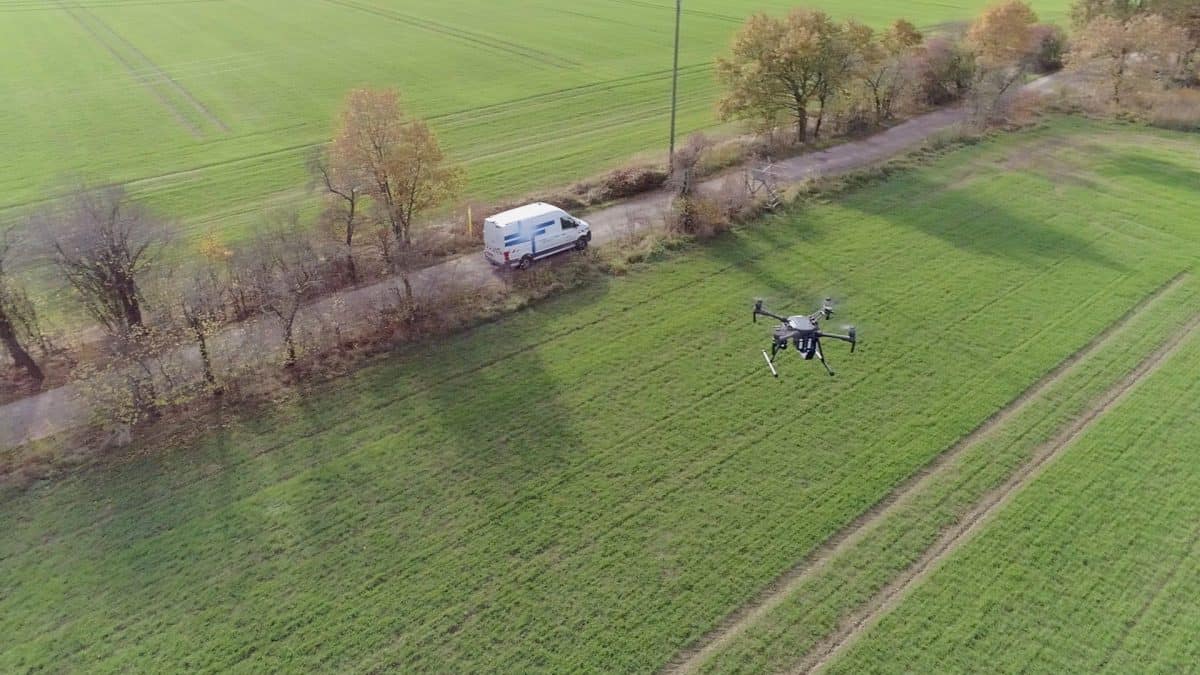The gas network operator MITNETZ GAS from eastern Germany has to check the tightness of around 3,500 km of gas pipelines every year. Gas leaks have devastating consequences: Not only the gas supply then no longer can be guaranteed, but the climate-damaging gas methane escapes.
To reduce methane emissions, rapid gas leak detection is essential. Drones can be used very effectively for this purpose.
Searching for Methane With Laser Beams
Equipped with the appropriate laser technology, the drone sends a laser beam to the ground at a flight altitude of 15 to 50 meters. Based on the reflection, the device can then detect whether methane is present here. The software can then automatically evaluate the measurements to identify any anomalies. The results are then compiled in color on a map so that the fitters can take targeted measures immediately.
At the beginning of November 2021, the proof of concept with MITNETZ GAS took place in Machern near Leipzig. For around 45 minutes, the professional drone successfully flew over 2 km of the underground pipeline network. With the help of FlyNex, the entire project management, from flight planning to data analysis, could be implemented entirely and straightforwardly in the FlyNex Enterprise Suite. In addition, FlyNex as project partner took over the exchange with the authorities to obtain all necessary permits for the inspection mission.

© MITNETZ GAS, 2021
Jana Erdmann, Project Manager Operations at MITNETZ GAS says:
“Especially in hard-to-reach areas like forests or across fields, this is a good option. We wanted to investigate this more closely to see if and how it works properly. Actually, during the first test, I didn’t expect the drone to find any abnormalities.”
Usually, the inspection of gas pipelines takes place on foot with a special measuring device. But for several thousand kilometers of gas pipeline, this is very time-consuming.
The support of the methane detectives from the air saves the 12 fitters responsible for gas leak detection at MITNETZ GAS a lot of time and does the preliminary work. Any anomalies detected by the drone must be rechecked on-site in any case. This is because natural processes such as rotting leaves can also produce methane.
This example shows how important gas leak detection is for climate change: Just one leak in the Yamal pipeline, which brings gas from Siberia to Germany, for example, generates as much climate damage as more than a million car drivers a year (Source: Tagesschau).
Flynex as a Partner of the enviaM Group
FlyNex has been accompanying the enviaM Group, of which MITNETZ GAS is a subsidiary, as a partner for a long time and also supports, for example, MITNETZ STROM in the automated inspection of power lines and towers with drones.
Commenting on the latest project with MITNETZ GAS, Michael Petrosjan, CFO and Co-Founder of FlyNex, said:
“It’s a lot of fun for us to develop new things together. We see how the applications work in practice and what companies and network operators value. For example, we have short-circuited with the company from Croatia on the topic of gas leak detection. When it comes to further tests next year, we are curious to see whether the results are target-oriented.”
EU Calls for Concrete Measures to Reduce Methane
The search for gas leaks with drones can make a certain contribution to reducing methane emissions. The decisive factor here is that drones can detect gas leaks much more quickly, and countermeasures can thus be initiated more swiftly.
In addition, gas network operators may soon be confronted with new legislation that could even make such measures mandatory. In October 2020, the EU Commission adopted a strategy to reduce methane emissions (EU Methane Strategy). Here, for example, improved monitoring of methane emissions is demanded. As a measure, an obligation to enhance the detection of gas leaks is proposed. Drones are very well suited for this purpose, as they can collect vast amounts of precise data quickly, easily, and in an environmentally friendly manner. Therefore, they are used not only for pipelines but also for oil platforms for methane gas detection.
Everyone Is Talking About CO₂: Facts About Methane (CH4)
- Methane is the second-largest contributor to the climate crisis after carbon dioxide (CO₂).
- Methane accounts for about 17% of greenhouse gases emitted worldwide (CO₂: 66%, nitrous oxide (N₂O): 7%, other gases: 11%).
- Methane is about 25 times more potent than CO₂ (from a 20-year perspective, it is even 84 times more potent).
- Methane remains in the atmosphere for around 12 years (CO₂ for over 1000 years).
Source:

